|
Physical investigation
June 2004
The purpose of the
present report is analyses and
generalizations of the architectural history of the Single Sisters’ House in
Winston-Salem, NC. It is one of the most significant national landmarks of
the United States. This report is dedicated to physical historical
investigation of the building that was performed in April-May of 2004. The
provided information is new and does not duplicate previous historical
reports. A selected bibliographical list is located at the end of the
report.
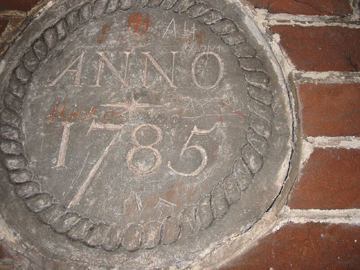 Single Sisters’
House is extremely important for
both the local community and national history. An extensive physical
historical investigation is a necessary first step in developing the
substantiated restoration and adaptive reuse projects. Unfortunately,
limited time did not allow completing the full spectrum of comprehensive
research. However, it was possible to provide the main portion of the
information that resulted in better understanding of the historical,
methodological and structural problems, to create a general strategy and to
develop recommendations for the conservation and adaptive reuse projects
based on reliable information. Further research can be done in the future
for the entire building and its parts and details. Single Sisters’
House is extremely important for
both the local community and national history. An extensive physical
historical investigation is a necessary first step in developing the
substantiated restoration and adaptive reuse projects. Unfortunately,
limited time did not allow completing the full spectrum of comprehensive
research. However, it was possible to provide the main portion of the
information that resulted in better understanding of the historical,
methodological and structural problems, to create a general strategy and to
develop recommendations for the conservation and adaptive reuse projects
based on reliable information. Further research can be done in the future
for the entire building and its parts and details.
Future research should
be performed under extreme care in order not to damage the building’s
historical fabric. Removing the entire plaster from the walls is
unacceptable.
The Single Sisters’
House is located at the Southeast side of the Salem
Public Square. The large length of the building plays a significant role in
forming the square shape. The house has a simple rectangular shape in plan
and gable roof.
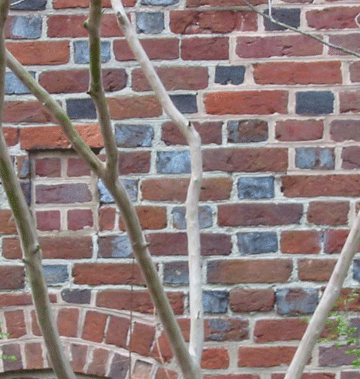 Light fieldstone was
used on the original north end of the building of the building, dated 1786.
The Southern base, dated 1819, was made with brick that at present time is
plastered with cement plaster. Walls of both these time periods were
constructed with brick. The
entire exterior surface of the addition has a Flemish bond masonry. It was the most common technique in Winston-Salem
in the 18th century (excluding infilling frame structures, which
had a Running bond). Corners were done using ¼ closers next to the headers.
The elevations are patterned with glossy black headers. Some headers lost
their glossy surfaces due to weathering and painting on elevations. Two
types of rodded joints were found on the elevations: Flush and Struck.
Struck type was not very common at that time (1786) and was not as deep as
it became later in the 19th century. Average brick sizes are:
11.85”x5.275”x2.825”. (Three more buildings were erected in Winston-Salem
with the same oversized brick: Tavern (1784), Brothers’ House addition
(1786) and Boys’ School (1794). Calculated average joint width is 0.78”,
which is also irregular, larger than usually. Light fieldstone was
used on the original north end of the building of the building, dated 1786.
The Southern base, dated 1819, was made with brick that at present time is
plastered with cement plaster. Walls of both these time periods were
constructed with brick. The
entire exterior surface of the addition has a Flemish bond masonry. It was the most common technique in Winston-Salem
in the 18th century (excluding infilling frame structures, which
had a Running bond). Corners were done using ¼ closers next to the headers.
The elevations are patterned with glossy black headers. Some headers lost
their glossy surfaces due to weathering and painting on elevations. Two
types of rodded joints were found on the elevations: Flush and Struck.
Struck type was not very common at that time (1786) and was not as deep as
it became later in the 19th century. Average brick sizes are:
11.85”x5.275”x2.825”. (Three more buildings were erected in Winston-Salem
with the same oversized brick: Tavern (1784), Brothers’ House addition
(1786) and Boys’ School (1794). Calculated average joint width is 0.78”,
which is also irregular, larger than usually.
For economical reasons
the interior walls were built
without any black pattern. For the same reason the
joints were not rodded. The shallow weathered and struck joints on the
interior masonry surface can be explained by the intent to plaster the walls
later. Rough surfaces with these joints hold plaster much better. Brick
sizes and joint width in the interiors are equal to the same parameters on
the elevations. However, interior masonry surface is not as accurate and
smooth as exterior ones.
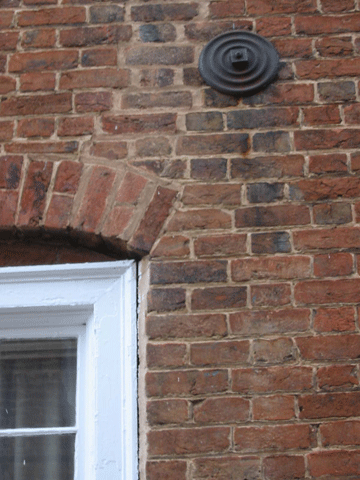 The elevations of the
South addition do not have black header patterns, but they are laid out with
the same type of bond as the North part: Flemish. Corners are formed using
both ¼ queen closers and three quarters. Joints are
formed with a Struck type that had been developed by that time period (1819)
and existed in the same shape during the entire 19th century. The elevations of the
South addition do not have black header patterns, but they are laid out with
the same type of bond as the North part: Flemish. Corners are formed using
both ¼ queen closers and three quarters. Joints are
formed with a Struck type that had been developed by that time period (1819)
and existed in the same shape during the entire 19th century.
The most significant
alterations in brick masonry were done in 1841. A new wall was erected in
the kitchen at that time and the original 18th century door
openings were filled in. Bond type is a Common 4th
and 5th course header. The joints were formed as Weathered and
Flush. The average brick sizes are 8. 3”x3.9”x2.75”. Winston-Salem buildings
of the same time period have similar sizes: first addition to the
Inspector’s House – 8.25”x3.9”x2.72” (1838) and Cape Fear Bank –
8.28”x3.78”x2.78” (1847).
The two-story space of
the Single Sisters’ house with a basement and two attic levels (Basement
Plan, First Floor Plan,
Second Floor Plan, Third Floor Plan,
Attic Plan) was initially served by two stairs. The stairs were not equal in their
importance and sizes. The South stair (now it is the middle stair) was the
Main one. The North stair, which served basement food storage and first
floor Kitchen, can be named the Utility stair. The Main stair lead from the
basement to the third floor dormitory.
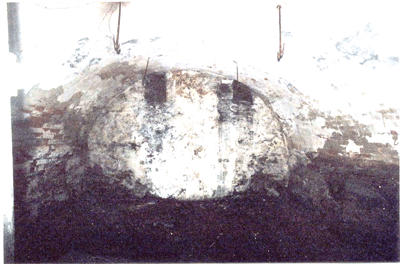
The original
basement was not extended
under the entire house plan. The very North
area did not have basement, which can be explained by
three reasons:
·
Kitchen stoves required
separate large foundations
·
High possibility of fire
·
High possibility of water
penetration to the floor below.
The North partition of
the basement was vaulted because:
·
The vault allows the basement
to maintain a stable temperature throughout the year. That is important for
food storage.
·
In case of fire the entire
house can burn down except vaulted spaces. That was important for storing
the most valuable property (one of the rooms in the vaulted basement was
used for such a function). The stone stair entrance to the vaulted basement
is also vaulted.
The entrance opening to
the vaulted basement contains evidence of a missing door. This door may have
been made from iron.
The South part of the original basement
has a usual flat wooden ceiling and is separated from the North portion with
a wall. The basement is organized as two isolated rooms with entrances from
a large stair hall. The ceiling height in all the basement spaces at the
present time (including vaulted rooms) is around 114”. One of the goals of
further research is determining the original floor levels.
The historical field
research allowed developing a reconstruction of the original plans. The first floor at the North section
initially had three rooms. The Eastern room was used for the kitchen, which
had one door opening leading to the North stair hall. Two western rooms were
isolated from the stair hall and from each other, which means that both
rooms had a door entrance from the kitchen. So both of those rooms were used
for kitchen needs. The kitchen equipment could have occupied one room and a
kitchen sister could have lived in another.
The Middle and South
sections on the first floor had
two rooms each. They were isolated from each other and had communication
with the stair halls.
The second floor has a similar plan except
the middle section that originally had a large room on the West side. This
room was used for community meetings and as a chapel.
The third floor
dormitory space basically still
has the original plan situation and elements, which were formed in the late
18th century.
Generally, the 1786
plan (drawings 5-6) is similar to the plan of the Gamain House
(demolished in the very early 19th century). The Gamain House was
also divided into 3 parts by 2 stair halls. Obviously, the Gamain House
served as a sample for the Single Sisters’ House.
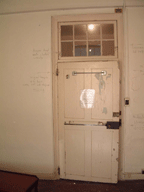 The 1819 South
addition was built with its own
stair. Basement and first floor were divided into East and West rooms at
each floor. The entire space of the second floor was used as a chapel. The
third floor was used as a dormitory. Originally the third floor of the
addition did not have a direct connection with the 18th century
dormitory space because the original stair was located along the North wall
and prevented from providing a door opening. Obviously, it was one of the
reasons for modification and relocation of the original stair in the
addition. The 1819 South
addition was built with its own
stair. Basement and first floor were divided into East and West rooms at
each floor. The entire space of the second floor was used as a chapel. The
third floor was used as a dormitory. Originally the third floor of the
addition did not have a direct connection with the 18th century
dormitory space because the original stair was located along the North wall
and prevented from providing a door opening. Obviously, it was one of the
reasons for modification and relocation of the original stair in the
addition.
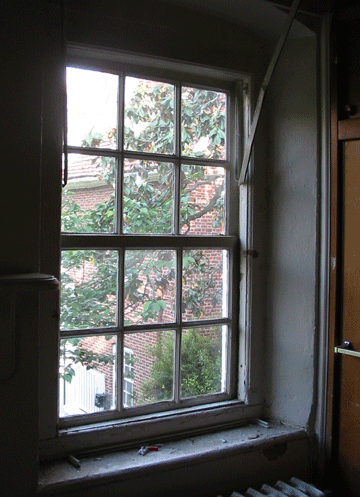 Some of the
alterations were done between 1786 and 1819 (Basement
Plan, First Floor Plan,
Second Floor Plan, Third Floor Plan,
Attic Plan). For instance, beams and studs for ceiling reinforcement were
added in the 1789. In 1812 the dormers were installed. During this time
period the wall between stair (room 2-1) and chapel (room 2-2) was erected.
Probably, it was done at the very beginning of the 19th century,
when the Home Moravian Church was built (1800) and existing meeting room and
chapel in the Single Sisters’ House were no longer needed. Some of the
alterations were done between 1786 and 1819 (Basement
Plan, First Floor Plan,
Second Floor Plan, Third Floor Plan,
Attic Plan). For instance, beams and studs for ceiling reinforcement were
added in the 1789. In 1812 the dormers were installed. During this time
period the wall between stair (room 2-1) and chapel (room 2-2) was erected.
Probably, it was done at the very beginning of the 19th century,
when the Home Moravian Church was built (1800) and existing meeting room and
chapel in the Single Sisters’ House were no longer needed.
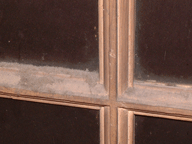 The most notable
alterations in the interiors were done in 1841 (First Floor Plan,
Second Floor Plan). Some of the doors and walls were relocated and the corridor in the first
and second floors was established in the middle of the original portion of
the house. As a result the interior circulation became much more convenient.
The Main stair between the first and second floors was also modified. The
South stair was relocated and altered to provide communication between old
and new parts of the building. It is quite possible that the south 1819
stair continued from the first floor to the basement between 1819 and 1841. The most notable
alterations in the interiors were done in 1841 (First Floor Plan,
Second Floor Plan). Some of the doors and walls were relocated and the corridor in the first
and second floors was established in the middle of the original portion of
the house. As a result the interior circulation became much more convenient.
The Main stair between the first and second floors was also modified. The
South stair was relocated and altered to provide communication between old
and new parts of the building. It is quite possible that the south 1819
stair continued from the first floor to the basement between 1819 and 1841.
In the second half
of the 19th century the building underwent various minor
changes.
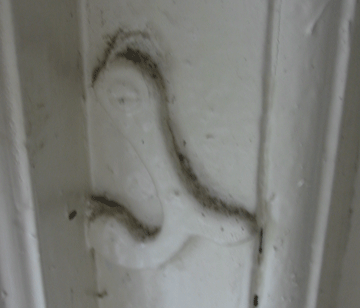 All of the entrance
doors are original with some slight modifications in
details. The sizes,
locations, hardware and details of the interior doors were changed more
extensively, but still provide enough information for dating and restoration
to reflect the initial appearance . There is three door
types in the building:
late 18th century, 1819 and 1841 with specific features, which
belong to each particular chronological type. Windows also fit into the same
chronological categories
.
The width of the window Muntins is
different
for the different time periods: All of the entrance
doors are original with some slight modifications in
details. The sizes,
locations, hardware and details of the interior doors were changed more
extensively, but still provide enough information for dating and restoration
to reflect the initial appearance . There is three door
types in the building:
late 18th century, 1819 and 1841 with specific features, which
belong to each particular chronological type. Windows also fit into the same
chronological categories
.
The width of the window Muntins is
different
for the different time periods:
·
1786 = 1”
·
1819 = ¾ “
·
Second half of the 19th
century = ½”.
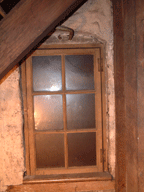 1786
and 1819 window openings had a feature
that allowed lowering the top sashes for
ventilation: 12” in the 18th century and 9” in 1819. Upper level
windows at the South and North elevations have one-leave casement sashes,
which is traditionally for Winston-Salem. Both original types of the
casement windows survived in the Single Sisters’ House: 1786 and 1819. 1786
and 1819 window openings had a feature
that allowed lowering the top sashes for
ventilation: 12” in the 18th century and 9” in 1819. Upper level
windows at the South and North elevations have one-leave casement sashes,
which is traditionally for Winston-Salem. Both original types of the
casement windows survived in the Single Sisters’ House: 1786 and 1819.
Two fireplaces
remain on the first floor of the South addition. Judging by the molding
profiles both fireplaces can be dated by 1819.
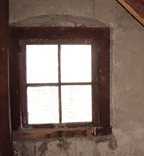 The
interior walls
were basically plastered and whitewashed. The main stair walls have a
numer of paint layers. Some of them are of a peach color.
A baseboard was
painted on the plaster above the first original landing of the Main stair.
This painted baseboard had a gray color with a black top line that imitated
a top molding. A gray baseboard with a dark red top line was found on the
South wall of the stair hall. The baseboard was applied there after 1841. The
interior walls
were basically plastered and whitewashed. The main stair walls have a
numer of paint layers. Some of them are of a peach color.
A baseboard was
painted on the plaster above the first original landing of the Main stair.
This painted baseboard had a gray color with a black top line that imitated
a top molding. A gray baseboard with a dark red top line was found on the
South wall of the stair hall. The baseboard was applied there after 1841.
Preliminary paint analyses were done for the
elevations (Paint Inspections 1, 2). After erection in 1786
white lines were drawn along the joints. Later the
brick walls were painted with red color. This was done not long after the
construction, because by 1819 almost all paint was gone from the elevations
(drawings 11, 12).
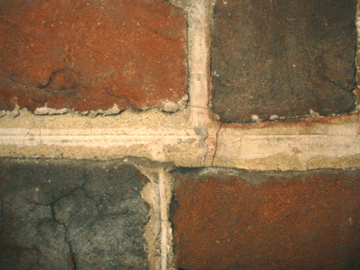 The first layer of the 1819 joints is white. It is
not clear if the whole exterior was whitewashed or only white lines between
bricks were drawn. This question shall be answered during future research.
Later the entire elevations were painted in orange color with white lines
along the joints. And finally, the exterior walls were painted in orange
without white lines. The first layer of the 1819 joints is white. It is
not clear if the whole exterior was whitewashed or only white lines between
bricks were drawn. This question shall be answered during future research.
Later the entire elevations were painted in orange color with white lines
along the joints. And finally, the exterior walls were painted in orange
without white lines.
Some of the building’s
elements were not included in the current research completely
or partially.
·
Floors: Dating of the floor
elements remains a task of future research. However, the floor investigation
in some of the rooms shall be completed at this time. Too big of a variation
in floor levels can create a problem in providing an accessible route
throughout the house (for instance, between rooms 1-1 and 1-2).
·
StAirs: Replacement of the
existing stairs with new ones approaching in their appearance to the
original time period cannot be recommended. Such alteration will require
removing the memorial and architecturally valuable historical elements.
Furthermore, the project team does not have enough information to restore
the stairs completely to reflect the initial design. At the same time the
stairs contain many late 20th century elements, which are
recommended for removal. Additional research shall be done on all of the
stairs to make the final decision.
·
Additional research is
required for the dormers. Both historical accuracy and aesthetical
appearance should be considered in developing recommendations of their
treatment.
·
Color analyses in the current
report is preliminary. More research of the interiors and elevations is
recommended in the future.
·
All the
windows and doors should
be further studied to determine the original hardware, sizes and locations.
For the current conservation and adaptive reuse project the use of the
contemporary hardware can be recommended.
·
Historical inventory shall be
done for the remaining door and window hardware and for the old glass panels
of the window and door transoms.
·
Measurement shall be done for the
doors, windows and dormers, which are typical to each chronological time
period.
·
The excavation at the exterior
walls shall be conducted in order to determine the original and later
historical ground levels. Excavation at the connection of the
original 1789 part of the building and 1819 addition on the East side is the
first required step.
The Preservation
philosophy has to be based on the
national and international standards and practical experience with
considerations of the local conditions related to the particular monument.
The upcoming preservation works on the building could be defined as a
general conservation with fragmentary restoration. Conservation
in this case means structural reinforcement, prevention of destructions and
maintaining on a permanent basis. It relates to all structural and
decorative elements of the building. Fragmentary restoration is applicable
to the very minor building’s details and has a goal to preserve and
emphasize their historical and aesthetic values. For instance, one of the
original doors could be restored completely to give the idea of its initial
appearance.
The base statements
for the preservation works of the Single Sisters’ House.
·
The memorial period that is
significant for the Single Sisters’ House is between 1786 (erection) and
1896 (Single Sisters left the House). It means everything within this time
frame, including the additions and alternations has to be preserved and
maintained. At the same time we cannot ignore such a notable post Single
Sisters period as 1920s, which brought to the house some of the
aesthetically valuable elements and has a history behind it . The House can be used to learn about the American
architectural history with the entire set of alterations. The time period
recommended for preservation works on the building is 1786-1920s.
·
Application of new technology
has to be verified by tens of years of successful use. New materials used
during preservation works have to be compatible with existing ones.
·
New elements added, as a part
of the adaptive reuse, (partitions, doors, hardware, ducts, etc) must be
distinguishable from the historic fabric. At the same time they have to be
aesthetically neutral in relationship to the initial parts and finishes.
·
It is unacceptable to remove
any contribution that has been established for the building’s valuable time
periods. Even stripping old paint layers from the historical woodwork cannot
be recommended because valuable information may be lost. These layers are
subject for opening and exposing to illustrate the finished history of the
details of the building.
An entire interior
restoration could be done in the
future using the selected single rooms method. Rooms could be
restored one at a time, allowing the other parts of the building to
function.
Igor
Kiselev
June 2004
Selected BIBLIOGRAPHY
·
Grant Report to the Wachovia Historical
Society. By Beth Pearce and Julie
Risher. August, 1983
·
Less Time for Medding.
A history of Salem Academy and College. By Frances Griffin. John F.
Blair, Publisher.
Winston-Salem
·
Old Salem Single Sisters’ House Recording
Project. Historical background
research by David Bergstone. Old
Salem in North Carolina, 1994
·
Old Salem.
The official Guidebook. By Penelope Niven
and Cornelia B. Wright. Old Salem, Inc. Winston
Salem, NC. 2000.
·
Sisters.
By Susan Taylor. Salem Academy and
College. 1994.
·
The Secretary of the
Interiors. Standards for Historic Preservation Projects.
Developed by W. Brown Morton III and Gary L. Hume.
Washington, D.C. 1979.
·
The Venice Charter.
INTERNATIONAL CHARTER FOR THE CONSERVATION AND RESTORATION OF MONUMENTS AND
SITES. Congress of Architects and Technicians of Historic Monuments,
which met in Venice from May
25th to 31st 1964
|